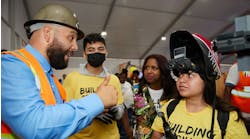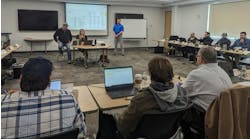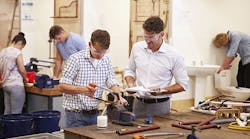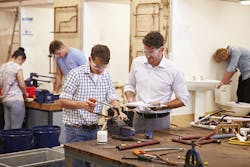Plumbers without training wing it on every call. The result is lost opportunity, money left on the table and more callbacks. Thus, a designed training program boosts sales, increases profit and reduces waste. Here’s how to put one together.
Professional athletes practice hours for every hour of game play. Ditto for musicians and other performers. You practice. You study. You learn. You tweak. You improve.
Concert violinist, Jascha Heifetz was considered, “the perfect violinist.” He said, “If I don't practice one day, I know it; two days, the critics know it; three days, the public knows it.”
How often do you train and practice? Once a week for 15 to 30 minutes during a service meeting? It’s not enough. Training is like bathing. It wears off, so practice it daily. Yes, daily. Hold training meetings at the start of each day. Starting the day on a positive note is especially important for a service company where your team disburses and acts on their own for the rest of the day.
Basic training needs
The first area is technical. Most plumbers are pretty good turning a wrench. That doesn’t mean they are technically proficient across the board. Look at your callback history and use that to identify technical deficiencies to improve with training. Periodically, train on fundamentals, such as brazing. Can they do it faster? Better?
The second area is soft skills. This excites company owners because better soft skills directly impact the top and bottom lines. Surprisingly, most plumbers eat it up as well. Who wouldn’t want to improve communication skills, listening skills and learn how to represent one’s self and the company better?
Finally, train on company procedures. Sometimes procedural training is related to a service call. These are the steps to follow. Other procedural training is related to company paperwork, such as the exact way you fill out an invoice.
Different learning styles
Each of us has a preferred learning style. The three styles are auditory (listening), visual (watching) and kinesthetic (doing). It is likely that the dominant learning style with plumbers is kinesthetic, or hands on.
According to research of secondary school students conducted by the University of Illinois, 50% of students learn by doing, 40% learn by watching and 10% learn by listening. Yet, 80% of instructional delivery is auditory.
That’s secondary schools. How about your company? Does most of your training consist of the owner or service manager lecturing to a room full of plumbers? How can you better engage your plumbers and make more training hands on?
Make it fun
There is not a law requiring training to be boring or dry. It can be fun. Make it fun by adding a competitive element to it. Ask technical or customer service questions and give points for getting the answer right. Give your plumbers 20 one-dollar bills for a truck inspection with the proviso that they have to give one back for each deficiency found.
Hold a contest to see who can sweat a line the fastest and cleanest. Have plumbers recite the features and benefits of the different products you sell while holding a burning match to represent the pressure of standing in front of a customer. Buy lunch for the plumbers who get the most. Get creative.
Utilize multiple training methods
While you should deliver training in the shop, you should not only deliver training in the shop. Explore the distance learning opportunities where people can take online courses that provide immediate feedback. Many contractors find these are ideal for training office staff.
Purchase books and pass them out to your team. Since most plumbers are not inclined to read long, ponderous tomes, buy short pithy books that can be read quickly. A good place to start is Mark Matteson’s “Freedom From Fear.”
Supplement your classroom training with training videos. You can find many on YouTube. A one to five minute video provides a break and adds life to a training session. You can also purchase professional training videos designed to deliver a message and entertain. An excellent series is Charlie Greer’s Tec Daddy DVDs.
Audio programs are nearly unlimited today. A variety of training and motivational programs are available as CDs or in MP3 format. A growing array of podcasts are available that can be downloaded to a smart phone and podcasts are free. While auditory learning is not the best method for plumbers, they are spending a lot of time behind the wheel. Instead of political or sports talk, listen to something that will boost earnings!
Classroom training is also offered by third parties, including local trade schools, trade associations, manufacturers, and consultants. Take advantage of them when they are in town.
Of course, for the kinesthetic learner, maybe the best training is on the job in the form of ride-alongs. Some of your plumbers can ride along with your top performers to see and learn how they do it. You can ride along with struggling plumbers to offer tips and encouragement.
Create a training plan
Every quarter, you should map out a training plan so that you identify what your objectives are for each week, identify what is available from third parties, and what resources you need. Moreover, create individualized training plans for each plumber. Take into account their preferences. You can even tie some of the training into the achievement of certain goals.
Don’t forget yourself
Finally, do not forget that you need training too. Often, the business owner is the last person to get any training. You need it just as much as your team. Start with Comfortech this September in St Louis. It is the best training opportunity left this year. Don’t miss it. For more information on Comfortech and to register go to: http://bit.ly/1IIbqx2.
Matt Michel is CEO of the Service Roundtable, contracting’s largest business alliance. To purchase Mark Matteson’s books and Charlie Greer’s training programs, visit Shop.ServiceRoundtable.com. To learn more about Comfortech, visit ComfortechShow.com. For information on a variety of training and other resources for contractors, visit ServiceRoundtable.com or call 877.262.3341.



